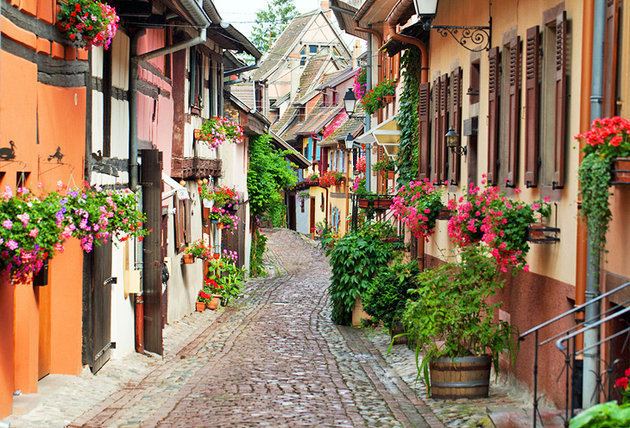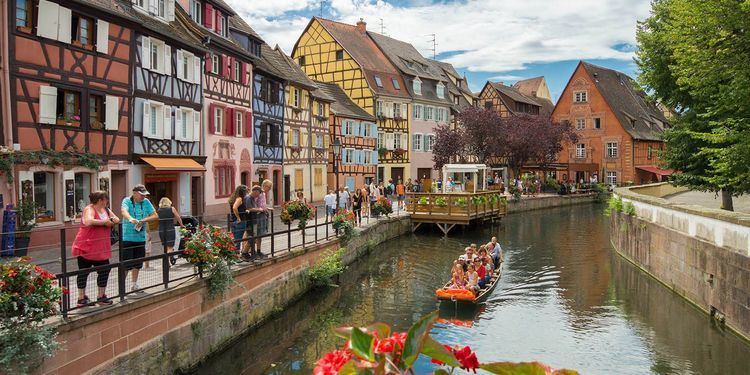Country Region | Area 65,713 Mayor Gilbert Meyer | |
 | ||
Recent posts on Google+ | ||
Map of Colmar
Colmar (French: Colmar, [kɔlmaʁ]; Alsatian: Colmer [ˈkolməʁ]; German during 1871–1918 and 1940–1945: Kolmar) is the third-largest commune of the Alsace region in north-eastern France. It is the seat of the prefecture of the Haut-Rhin department and the arrondissement of Colmar-Ribeauvillé.
Contents
- Map of Colmar
- Colmar france alsaces most enchanting city
- Dijon colmar strasbourg france slide show mov
- History
- Geography
- Climate
- Main sights
- Architectural landmarks
- Secular buildings
- Religious buildings
- Fountains
- Monuments
- Museums
- Library
- Transport
- Education
- Music
- Economy
- Parks and recreation
- Notable people
- Replicas of historical Buildings in Malaysia
- Media
- References

The town is situated on the Alsatian Wine Route and considers itself to be the "capital of Alsatian wine" (capitale des vins d'Alsace). The city is renowned for its well-preserved old town, its numerous architectural landmarks, and its museums, among which is the Unterlinden Museum, with the Isenheim Altarpiece.

Colmar france alsaces most enchanting city
Dijon, colmar & strasbourg, france slide show mov
History

Colmar was founded in the 9th century and is mentioned as Columbarium Fiscum by the monk Notker Balbulus in a text dated 823. This was the location where the Carolingian Emperor Charles the Fat held a diet in 884. Colmar was granted the status of a free imperial city by Emperor Frederick II in 1226. In 1354 it joined the Décapole city league. In 1548 Josel of Rosheim urged the Reichskammergericht court to repeal the Colmar market ban on Jewish merchants. The city adopted the Protestant Reformation in 1575, long after the northern neighbours of Strasbourg and Sélestat. During the Thirty Years' War, it was taken by the Swedish army in 1632, which held it for two years. In 1635 the city's harvest was spoiled by Imperialist forces while the residents shot at them from the walls.

The city was conquered by France under King Louis XIV in 1673 and officially ceded by the 1679 Treaties of Nijmegen. With the rest of Alsace, Colmar was annexed by the newly formed German Empire in 1871 as a result of the Franco-Prussian War and incorporated into the Alsace-Lorraine province. It returned to France after World War I according to the 1919 Treaty of Versailles, was annexed by Nazi Germany in 1940, and then reverted to French control after the battle of the "Colmar Pocket" in 1945. Colmar has been continuously governed by conservative parties since 1947, the Popular Republican Movement (1947–1977), the Union for French Democracy (1977–1995) and the Union for a Popular Movement (since 1995), and has had only three mayors during that time.
The Colmar Treasure, a hoard of precious objects hidden by Jews during the Black Death, was discovered here in 1863.
Geography
Colmar is 64 kilometres (40 mi) south-southwest of Strasbourg, at 48.08°N, 7.36°E, on the Lauch River, a tributary of the Ill. It is located directly to the east of the Vosges Mountains and connected to the Rhine in the east by a canal.
In 2013, the city had a population of 67,956, and the metropolitan area of Colmar had a population of 126,957 in 2009. Colmar is the center of the arrondissement of Colmar-Ribeauvillé, which had 199,182 inhabitants in 2013.
Climate
Colmar has a sunny microclimate and is one of the driest cities in France, with an annual precipitation of just 607 mm (23.9 in), making it ideal for Alsace wine. It is considered the capital of the Alsatian wine region.
The dryness results from the town's location next to mountains, which force clouds arriving from the west to rise, and much of their moisture to condense and fall as precipitation over the higher ground, leaving the air warmed and dried by the time it reaches Colmar.
Main sights
Mostly spared from the destructions of the French Revolution and the wars of 1870–1871, 1914–1918 and 1939–1945, the cityscape of old-town Colmar is homogenous and renowned among tourists. An area that is crossed by canals of the river Lauch (which formerly served as the butcher's, tanner's and fishmonger's quarter) is now called "little Venice" (la Petite Venise).
Architectural landmarks
Colmar's secular and religious architectural landmarks reflect eight centuries of Germanic and French architecture and the adaptation of their respective stylistic language to the local customs and building materials (pink and yellow Vosges sandstone, timber framing).
Secular buildings
Religious buildings
Fountains
Monuments
Museums
Library
The Municipal Library of Colmar (Bibliothèque municipale de Colmar) owns one of the richest collections of incunabula in France, with more than 2,300 volumes. This is quite an exceptional number for a city that is neither the main seat of a university, nor of a college, and has its explanation in the dissolution of local monasteries, abbeys and convents during the French Revolution and the subsequent gift of their collections to the town.
Transport
The small regional Colmar Airport serves Colmar.
The railway station Gare de Colmar offers connections to Strasbourg, Mulhouse, Besançon, Zürich and several regional destinations. Colmar was also once linked to Freiburg im Breisgau, in Germany and on the other side of the Rhine, by the Freiburg–Colmar international railway. However the railway bridge over the Rhine between Breisach and Neuf-Brisach was destroyed in 1945 and never replaced.
Education
Senior high schools in Colmar include:
Colmar shares the Université de Haute-Alsace (Upper Alsace University) with the neighbouring, larger city of Mulhouse. Of the approximately 8,000 students of the UHA, around 1,500 study at the Institut universitaire de technologie (IUT) Colmar, at the Colmar branch of the Faculté des Sciences et Techniques and at the Unité de Formation et de Recherche Pluridisciplinaire d'Enseignement Professionalisé Supérieur (UFR PEPS).
The École Compleméntaire Pour L'Enseignement Japonaise a Colmar (コルマール補習授業校 Korumāru Hoshū Jugyō Kō), a part-time supplementary Japanese school, is held in Colmar. At one time classes were held at the Centre Cultural de Seijo.
Music
Since 1980, Colmar is home to an international summer festival of classical music Festival de Colmar (also known as Festival international de musique classique de Colmar). In its first version (1980 to 1989), it was placed under the artistic direction of the German conductor Karl Münchinger. Since 1989, it is helmed by the Russian violinist and conductor Vladimir Spivakov.
Economy
Colmar is an affluent city whose primary economic strength lies in the flourishing tourist industry. But it is also the seat of several large companies: Timken (European seat), Liebherr (French seat), Leitz (French seat), Capsugel France (A division of Pfizer).
Every year since 1947, Colmar is host to what is now considered as the biggest annual commercial event as well as the largest festival in Alsace, the Foire aux vins d'Alsace (Alsacian wine fair).
When Air Alsace existed, its head office was on the grounds of Colmar Airport.
Parks and recreation
By 1991 Lycée Seijo, a Japanese boarding high school in Kientzheim, had established a Japanese cultural center. It housed books and printed materials in Japan and hosted lectures and film screenings.
Notable people
Replicas of historical Buildings in Malaysia
Bukit Tinggi Resort Colmartropicale Bentong is copy of Colmar historical city in Malaysia, an hour or 60 km north-east of Kuala Lumpur, 3.400787°N 101.839157°E / 3.400787; 101.839157. North of it, a rebuild of Château du Haut-Kœnigsbourg is in the Berjaya Hills, hosting an organic resort hotel., 3.404167°N 101.839155°E / 3.404167; 101.839155.
Media
Colmar's cityscape (and neighbouring Riquewihr's) served for the design of the Japanese animated film Howl's Moving Castle. Scenes in the anime Is the Order a Rabbit? are also based on this location.
